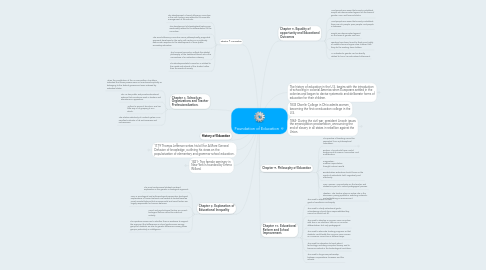Foundation of Education
by Jacob Gobble


1. Chapter 7. Curriculum
1.1. The development of social efficiency curriculum in the 20th century was related to the scientific management of the schools.
1.2. The development of standardized testing was inextricably related to the differentiation of the curriculum.
1.3. The social efficiency curriculum was a philosophically pragmatist approach developed in the early 20th century as a putatively democratic response to the development of mass public secondary education.
1.4. The humanist curriculum reflects the idealist philosophy of the traditional liberal arts is the cornerstone of an education citizenry.
1.5. The developmentalist curriculum is related to the needs and interest of the student rather than the needs of society.
2. 1779 Thomas Jefferson writes his bill for A More General Defusion of knowledge, outlining his views on the popularization of elementary and grammar school education.
2.1. Project Start
2.1.1. Project specifications
2.1.2. End User requirements
2.1.3. Action points sign-off
2.2. Development Stage 1
2.2.1. Define actions as necessary
2.3. Development Stage 2
3. 1821- Troy female seminary in New York is founded by Emma Willard.
3.1. Project Sponsor
3.2. Project Manager
3.3. Developers
3.4. Primary User Group
3.5. Supporting Staff
4. History of Education
5. Chapter 6. Schools as Organizations and Teacher Professionalization.
5.1. When the constitution of the US was written, its authors indicated that those powers were not mentioned explicitly as belonging to the federal government were retained by individual states.
5.2. The US has public and private educational systems that sometimes work in tandem and sometimes in opposition.
5.3. Without a sense of structure, one has little way of of grasping it as a whole.
5.4. The relative selectivity of a school system is an excellent indicator of its exclusiveness and inclusiveness.
6. Chapter 9. Explanation of Educational Inequality
6.1. The most controversial student-centered explanation is the genetic or biological argument.
6.2. From a sociological and anthropological perspective, biological explanations of human behavior are viewed as limited because social scientist believe that environmental and social factors are largely responsible for humans behavior.
6.3. Social and psychological factors are crucial, biological factors cannot be ruled out entirely.
6.4. The question remains as to whether there is evidence to support the argument that differences in school performance among groups of students are due to genetic differences among these groups, particularly in intelligence.
7. The history of education in the U.S. begins with the introduction of schooling in colonial America when Europeans settled in the colonies and began to devise systematic and deliberate forms of education for their children.
7.1. Definition
7.2. Items to be Delivered
7.3. Extent
7.3.1. Included
7.3.2. Included
7.3.3. Excluded
8. 1833 Oberlin College in Ohio admits women, becoming the first co-education college in the U.S.
9. 1863- During the civil war, president Lincoln issues the emancipation proclamation, announcing the end of slavery in all states in rebellion against the Union.
9.1. Schedule
9.2. Budget
9.3. Resources
9.4. Delays
10. Chapter 5. Philosophy of Education
10.1. The practice of teaching cannot be separated from a philosophical foundation.
10.1.1. Idealism- The teacher plays an active role in the discussion, posing questions, selecting materials, and establishing an environment.
